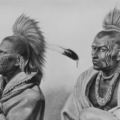Land of Masks: the Enigma of James Brown

“Lemme tell you something, Rev. When you kill’em, Rev, you leave. You kill’em and leave. You understand that, son? Kill’em and leave.”
—James Brown to a young Al Sharpton
The Godfather of Soul is not as known now as he used to be. That fact alone would have James Brown turning in his grave, messing up his perfectly coiffed pompadour. Brown spent his life working his damnedest to maintain an irreproachable aura of importance and memorability. He wanted to be known to posterity.
Here’s James McBride to save the day. With his new biography of the artist, Kill ’Em and Leave, McBride offers readers the clean and proper as well as the soiled and damaged James Brown. That Brown requires this volume is the underlying tragedy of Kill ’Em and Leave; in the end, this is a tragedy due to the intrusion of American “cultural history”—a vast vacuum that sucks in black-inspired art forms and leaves black artists void of recognition—into the space of this important American artist.
McBride uses the term “cultural history” throughout the book as a frame to examine the ways the American entertainment industrial complex and mainstream American cultural institutions sabotage black historical narratives and black creative achievements. Kill ’Em and Leave becomes a plaintive cri de coeur, lambasting Hollywood, academic institutions, and corporations for ignoring or pulverizing the legacy of James Brown.

Kill ’Em and Leave: Searching for James Brown and the American Soul
by James McBride
Hardcover, $28.00
Spiegel & Grau, 2016
Death has been hard on Brown’s legacy, in both senses of the term: his estate has experienced uninterrupted legal turmoil, and his public image has been the subject of ridicule and malice—among those who know better (his ex-wives and his own children and family), among those who don’t give a damn (Hollywood and South Carolina politicians), and as a result of his own preposterous and truly damaging choices (his abuse of women, his use of PCP).
It’s remarkable how consistent the motivations seem to be. As Biggie said, it’s all about the Benjamins. The pursuit of money and all its trappings pushed Brown to perform outlandish acts of paranoia—like putting $10,000 in the floor boards of a five-star hotel and picking it up several years later. In the end, his estate was estimated to be worth $100 million. Those to whom that hundred million “I Feel Good” charitable trust money is dedicated—i.e., poor school children, white and black in South Carolina and Georgia—are now suffering as a result of petty grievances and criminal greed.
In 2006, James Brown’s death ignited a contest between members of the Brown family, who seem to have wanted nothing more than to pilfer from his $100 million trust: his ex-wife, Tomi Rae Hynie; his daughters, Deanna and Yamma; as well as the good old boys of the South Carolina legal system. There’s also his manager, Buddy Dallas, and his accountant, David Cannon. Serving a sentence of six months in county jail and three years home probation, Cameron would become the fall guy for a ravenous Brown family.
Brown hired Cameron and Dallas to clean up his debt to the IRS, which was about $15 million (they reduced it to $1.3 million). They worked with Brown for several years and managed his business affairs. After years of urging him to do it, in 2000 Brown spent $20,000 in legal fees to have a will drafted. In this will he left his personal belongings to his children plus a $2 million education fund for his grandchildren to attend college, if they desired.
The rest he left to the poor children of Georgia and South Carolina.
His family has other ideas. So, it seems, does the South Carolina legal system, which has let the case fester in circuit courts for over a decade. One court split the proceeds between the Brown family and the poor children. Several sets of trustees have come and gone, including one who was replaced merely because she wanted to do what James Brown intended. Nearly forty-seven lawsuits have been filed regarding the estate and the trust, and recently the South Carolina Supreme Court has been forced to intervene.
This battle has ruined several lives, not least that of David Cannon, who lost his net worth of $4 million, a Myrtle beachfront house, and hundreds of thousands defending himself against the Brown family’s $7 million suit against him—for unduly influencing James Brown.
According to certain Brown insiders, “unduly influencing” is a stretch. No one ever told James Brown what to do with his money. As the Godfather himself said before his death, the doings of his estate were going to be a “mess.” A damn mess, more like it.
Brown was a revolutionary musician who changed the landscape of American music. His career serves as the great link that connects the past and present of black artistic innovation—Miles Davis, Louis Jordan, Michael Jackson, and Kendrick Lamar—into a formidable whole, giving us American sound. Says Al Sharpton, his protégé: “There’s the great Bs in music: Bach, Brahms, Beethoven, and Brown.” An exaggeration, but not by much.
James Brown was born in Barnwell, South Carolina, and lived in Augusta, Georgia, during his formative years. (Actually, ending up in a juvenile hall in Augusta for breaking and entering.) He earned his living working odd jobs, overwhelming his relatives and friends with his oppressive energy and pluck. Eventually, his talents found a home. Brown spent years performing in school gymnasiums and clubhouses during the era of the “chitlin circuit,” where black entertainers performed for mostly black crowds. Eventually, he joined the “Famous Flames,” which soon became “James Brown and the Famous Flames.”
McBride foregoes a strict chronological account of Brown’s career, and avoids going into much detail about Brown’s success aside from some spare words about the first Famous Flames recording “Please, Please, Please,” which was released by Cincinnati-based King Records, and the hit that would make Brown a star, “Try Me,” released as a solo record in October 1958. The key to understanding Brown’s transformation from circuit rider to megastar, according to McBride, was that Brown understood the white man:
In Brown’s world, the white man—whatever that phrase means these days—defined reality. From Brown’s point of view, nothing happened in this world—the sun didn’t rise, the moon didn’t rest, red traffic lights didn’t turn green—unless white folks said they did…
That fear—the knowledge that a single false step while wandering inside the maze of the white man’s reality could blast you back home with the speed of a circus artist being shot out of a cannon—is the kryptonite that has lain under the bed of every great black artist from 1925 radio star Bert Williams to Miles Davis to Jay Z.
Therein lies a key to Brown the man, too. McBride mentions again and again Brown’s vulnerability and fear—something exuberant showman was adept at hiding. It made him a lonely man and nearly ruined his life. It certainly affected his relationships. Along with this vast loneliness came the tragic death of his son. Doubly vulnerable, then, to life’s arrows and slingshots, the pressures and loss pushed Brown to become an often-cruel employer, husband, and friend.
McBride straightens out the rough edges of Brown’s biographical treatment throughout the years—an excruciatingly difficult task, because Brown makes it excruciatingly difficult—giving the reader episode after episode of his cruelty: he never paid his band enough; he would fine musicians for petty things like missing a cue, shoes that weren’t shined, missing a tie; he persuaded his musicians to buy expensive houses and cars, allow them to go into heavy debt, fire them, and then rehire them at a lower salary; he drove musicians through endless rehearsals after gigs, well into the following day; he traveled by private jet while his musicians rode the bus; he once slapped a musician; he once pulled a gun on a musician.
The intensity is certainly part of his legend, and Brown was a set of intense contradictions. He became, over the years, a figure of both generosity and cruelty, a Nixon Republican who loathed charity and maintained a bootstraps philosophy as well as a founder of the black pride movement and a civil rights icon, a serial abuser and a late-night TV punch line. It is the great truth of his life that Brown was calculating, mean, decent, and nearly imperturbable, a complex truth that sets McBride up for failure—his book getting us closer to but not inside the man:
Every truth contradicts another truth. Brown was crazy. Brown was a genius. Brown was a woman basher. Brown abated by gold digging woman. Brown was cheap. Brown would give away his last dime… And therein lies the real story of James Brown, who was more southern than he was black or white, more sensitive artist than he was superstar.
It is the sensitive artist in which the reader finds himself at a loss, a dimension asserted but never proven; possibly there, possibly here, but it would take a great leap of imaginative sympathy to unlock this deeply buried part of Brown.
The portrait McBride draws is a superstar playing a difficult part, flailing at a dramatis persona that imperfectly mirrors the public perception, and McBride’s sense of the American soul is dark. It begins and ends up with America’s phlegmatic non-resistance to a B.S. racial discourse, a point where James Brown serves as a useful conduit for the frank statements McBride’s makes in the book:
James Brown lived off … the high moral ground, of African American life…
During the civil right movement, which was his heyday, he epitomized that striving and pride of the African American struggle.
Brown was a race man extraordinaire, as anybody who ever listened to “Say It Loud: I’m Black and I’m Proud” can guess, and felt the weight of the black nation on his shoulders. It might explain his efforts, during the high period of his success, that failed about as often as they succeeded: a discount stamp for goods, a get-out the vote operation. McBride uses the South as the barometer of America’s slow progress toward racial conciliation. And it is slow:
You cannot understand Brown without understanding that the land that produced him is a land of masks. The people who walk that land, both black and white, wear masks and more masks, then masks beneath those masks.
With so much going for it, one does wish McBride’s righteous defense of Brown were able to become a definitive account of the soul master’s real self. It’s not possible, in the midst of legal fights and feuds. Instead, McBride reveals Brown as a flesh-and-blood legend, with foibles and humanity and, no doubt, greatness.





